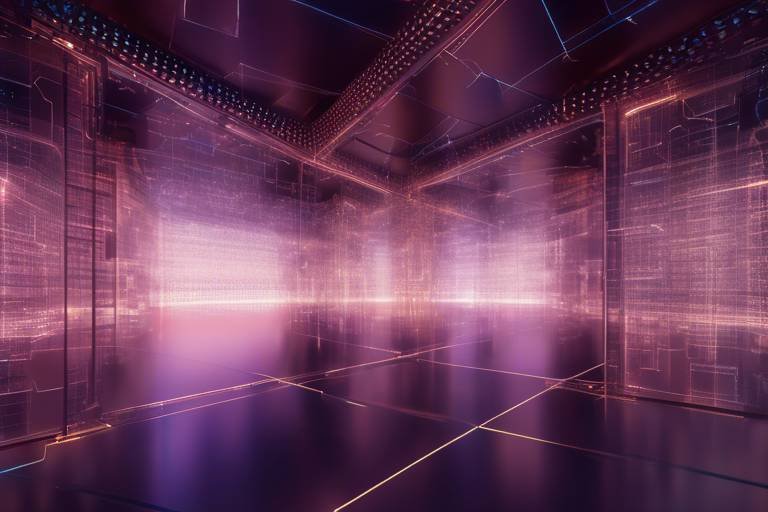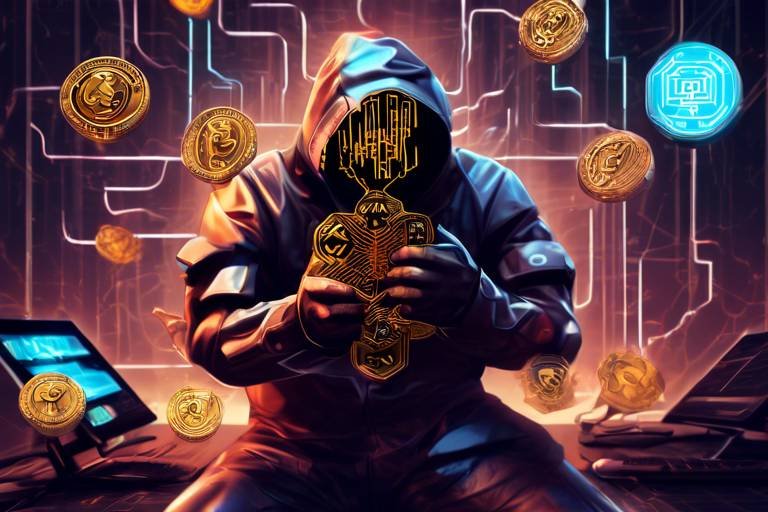Render Token - Decentralized GPU Rendering Network
In today’s fast-paced digital landscape, the demand for high-quality graphics is skyrocketing. From animated films to video games, the need for stunning visuals has never been greater. Enter Render Token, a revolutionary decentralized platform designed to transform the way we think about GPU rendering. Imagine a world where creators can tap into a vast network of computing power, drastically reducing rendering times while cutting costs. Sounds intriguing, right? This article will dive deep into the innovative concept of Render Token, exploring its numerous benefits, how it works, and its profound impact on digital content creation.
As the demand for intricate graphics continues to surge, traditional rendering methods often struggle to keep pace. Picture this: you’re a game developer with a brilliant idea, but your rendering process is bottlenecked by expensive hardware and long wait times. This scenario is all too common in the industry, where high costs and limited resources can stifle creativity and innovation. Decentralized rendering offers a fresh perspective, breaking down these barriers and providing a solution that is not only efficient but also accessible to everyone.
By leveraging a network of distributed GPUs, Render Token addresses the limitations of conventional rendering methods. Instead of relying on a single, powerful machine, users can share their idle GPU power, creating a collaborative environment where everyone benefits. This shift not only democratizes access to rendering capabilities but also fosters a community of creators who can share resources and ideas.
Understanding the mechanics behind Render Token is crucial for grasping its potential. At its core, Render Token operates on a decentralized architecture, allowing users to contribute their GPU power to the network. But how does this actually work? When a user offers their GPU resources, they are rewarded with Render Tokens, creating a mutually beneficial relationship. This system encourages participation and ensures that contributors are compensated fairly for their contributions.
User participation is vital for the success of Render Token. So, how can individuals get involved? The process is straightforward. Anyone with a compatible GPU can join the network, provided they meet certain requirements. These may include having a stable internet connection and the necessary software installed. Once set up, users can start rendering tasks and earn tokens in return. This creates an ecosystem where everyone, from hobbyists to professionals, can contribute and earn.
Setting up a rendering node is the first step for contributors looking to earn from the network. Here’s a simple step-by-step guide to get you started:
- Download and install the Render Token software on your machine.
- Configure your GPU settings to optimize performance.
- Create a wallet to store your Render Tokens.
- Connect to the Render Token network and start accepting rendering tasks.
By following these steps, you’ll be well on your way to becoming a valuable member of the Render Token community.
Token holders play a significant role in the ecosystem. Holding Render Tokens isn’t just about having a stake in the network; it comes with various incentives. For instance, token holders gain governance rights, allowing them to vote on important decisions regarding the platform’s future. Additionally, as the network grows and more users join, the value of Render Tokens may increase, providing potential profit for those who invest early. It’s a win-win situation that encourages long-term commitment and participation.
Smart contracts are integral to the functioning of Render Token. They automate transactions and ensure transparency and trust within the network. Imagine these contracts as digital referees, overseeing every transaction to guarantee fairness. When a rendering task is completed, smart contracts automatically distribute tokens to the contributor, eliminating the need for intermediaries and reducing the risk of fraud. This level of automation not only streamlines the process but also enhances the overall user experience.
The advantages of adopting Render Token extend beyond mere convenience. Here are some key benefits:
- Cost-Effectiveness: By utilizing a decentralized network, users can significantly reduce their rendering costs compared to traditional methods.
- Scalability: The platform can easily scale to accommodate growing demands, ensuring that rendering tasks are completed quickly and efficiently.
- Accessibility: Render Token opens up new possibilities for creators and developers, allowing anyone with a GPU to participate in the rendering process.
One of the standout features of Render Token is its cost efficiency. Traditional rendering methods often require expensive hardware and software licenses, putting them out of reach for many creators. In contrast, Render Token allows users to leverage shared resources, drastically reducing costs. Think of it as pooling resources with friends to rent a more powerful vacation home instead of booking a hotel alone—everyone saves money while enjoying the benefits.
Scalability is essential for meeting growing demands in the digital landscape. Render Token enhances performance through its decentralized architecture, allowing for faster and more efficient rendering processes. This means that as more users join the network, the rendering capabilities expand, leading to quicker turnaround times for projects. In a world where time is money, this improvement can make a significant difference for creators striving to deliver high-quality content.
What is Render Token?
Render Token is a decentralized GPU rendering network that allows users to share their GPU power and earn tokens in return.
How can I participate in the network?
Anyone with a compatible GPU can join by setting up a rendering node and connecting to the network.
What are the benefits of using Render Token?
Benefits include cost-effectiveness, scalability, and increased accessibility for creators and developers.
How do smart contracts work in Render Token?
Smart contracts automate transactions and ensure transparency, distributing tokens automatically upon task completion.

The Need for Decentralized Rendering
In today's digital landscape, where the demand for stunning visuals and intricate graphics is at an all-time high, the traditional methods of rendering often fall short. Imagine trying to create a masterpiece, only to be held back by slow processing times and limited resources. This is where decentralized rendering comes into play, offering a fresh perspective and a powerful solution to the bottlenecks that plague conventional systems.
Traditional rendering methods typically rely on centralized servers that can become overwhelmed with requests, leading to long wait times and increased costs. These centralized systems often struggle to keep up with the ever-growing demands of industries such as gaming, film, and virtual reality. As more creators seek to push the boundaries of what's possible, the limitations of these systems become glaringly apparent. The need for a more efficient and scalable solution is evident.
Decentralized rendering harnesses the power of a distributed network of GPUs, allowing users from around the globe to contribute their computational resources. By tapping into this collective power, Render Token aims to eliminate the constraints of traditional rendering methods. Here are some key benefits of decentralized rendering:
- Increased Efficiency: By distributing rendering tasks across multiple nodes, the workload is shared, resulting in faster processing times.
- Cost Reduction: Decentralized systems can significantly lower the costs associated with rendering, making high-quality graphics more accessible to creators of all sizes.
- Scalability: As the demand for rendering grows, so can the network, accommodating more users and resources without the bottleneck of a single server.
- Global Participation: Anyone with a capable GPU can join the network, democratizing access to rendering power and fostering a collaborative environment.
Furthermore, the rise of decentralized rendering aligns perfectly with the broader trend of decentralization in technology. Just as blockchain technology has transformed finance by removing intermediaries, Render Token aims to revolutionize rendering by creating a peer-to-peer network. This shift not only enhances performance but also empowers users, allowing them to take control of their resources and earn tokens in return.
In summary, the need for decentralized rendering is clear. As digital content creation continues to evolve, embracing this innovative approach will not only solve current limitations but also pave the way for a new era of creativity and collaboration. By leveraging the collective power of individual contributors, Render Token is poised to change the game for creators and developers alike.

How Render Token Works
Understanding how Render Token operates is essential for anyone interested in harnessing the power of decentralized GPU rendering. At its core, Render Token is built on blockchain technology, which allows for a seamless connection between users who need rendering power and those who can provide it. This innovative platform eliminates the need for centralized servers, which can often become bottlenecks in the rendering process, leading to delays and increased costs.
When a user wants to render a project, they submit their rendering tasks to the Render Token network. This network is composed of numerous nodes—each powered by individuals who contribute their GPU resources. To participate, users must first acquire Render Tokens, which serve as the currency within the ecosystem. These tokens are used to pay for rendering services, creating a fluid marketplace where demand and supply meet efficiently.
The architecture of Render Token is designed to optimize both performance and cost. Users who contribute their GPU power can earn tokens in return. This creates a win-win situation: creators get their projects rendered faster and at a lower cost, while GPU owners can monetize their idle processing power. The entire process is automated using smart contracts, which facilitate transactions, ensuring that contributors are compensated fairly and promptly.
Here’s a quick overview of how the process unfolds:
- Task Submission: Users submit their rendering tasks to the network.
- Node Selection: The network identifies available nodes based on their processing power and availability.
- Rendering: The selected nodes execute the rendering tasks using their GPU resources.
- Compensation: Upon completion, the contributors receive Render Tokens as payment.
This decentralized approach not only enhances the rendering speed but also reduces costs significantly when compared to traditional rendering farms. Users can access a broader range of resources and scale their projects without the constraints of physical hardware limitations. As more individuals join the network and contribute their GPU power, the overall capacity and efficiency of the Render Token platform increase, creating a robust ecosystem that benefits all participants.
Furthermore, the transparency provided by blockchain technology ensures that every transaction is recorded and verifiable, fostering trust among users. This is particularly crucial in the creative industry, where intellectual property and project integrity are paramount. By utilizing Render Token, creators can focus on their art without worrying about the underlying technicalities of rendering, knowing that their projects are in safe hands.

User Participation in the Network
When it comes to the success of Render Token, user participation is not just important—it's absolutely crucial. Imagine a bustling marketplace where everyone contributes their skills, and in return, they gain rewards. That's essentially how the Render Token network operates. Anyone with a capable GPU can join the network, providing their computational power to help render high-quality graphics for various projects. But how does one become part of this innovative ecosystem? Let's break it down.
First off, joining the network is as simple as setting up a rendering node. This process involves downloading the necessary software and configuring your system to start accepting rendering tasks. Think of it like plugging into a power grid; once you're connected, you can start generating energy—in this case, rendering power. The more power you contribute, the more you can earn in Render Tokens.
But it’s not just about the technical setup. There are a few requirements to keep in mind. Users need to have a compatible GPU, a stable internet connection, and some basic knowledge of how to operate rendering software. This ensures that the network runs smoothly and efficiently. Once you're set up, you can start accepting tasks and earning tokens, all while contributing to a decentralized network that benefits creators around the globe.
In addition to the technical aspects, there are also various rewards for active participants. By contributing your GPU power, you not only earn tokens but also gain access to exclusive features within the network. For instance, you might get priority in task assignments or even governance rights, allowing you to have a say in the future direction of the Render Token ecosystem. This community-driven approach fosters a sense of ownership and encourages more users to join.
Moreover, the rewards system is designed to be fair and transparent. Users can track their contributions and earnings through an integrated dashboard, which displays detailed metrics about their rendering tasks and the tokens they have accumulated. This level of transparency builds trust among participants, ensuring that everyone feels valued for their contributions.
In summary, user participation in the Render Token network is not just about providing GPU power; it's about becoming part of a vibrant community that values collaboration and innovation. Whether you’re a seasoned professional or just starting in the world of digital content creation, there’s a place for you in this network. So why not take the plunge? Join the decentralized revolution and start reaping the benefits today!
- What are the requirements to participate in Render Token? Users need a compatible GPU, a stable internet connection, and basic knowledge of rendering software.
- How can I earn tokens? By setting up a rendering node and contributing your GPU power to the network, you can earn tokens for every rendering task you complete.
- What are the benefits of holding Render Tokens? Token holders gain governance rights and potential profit from the growth of the network.
- Is it easy to set up a rendering node? Yes, the setup process is straightforward and can be done with user-friendly software provided by the Render Token platform.

Setting Up a Rendering Node
Setting up a rendering node on the Render Token network is an exciting opportunity for anyone looking to contribute to decentralized GPU rendering while earning tokens in the process. The journey begins with ensuring that your hardware meets the necessary requirements. A powerful GPU is essential, as it will be the backbone of your rendering capabilities. Additionally, having a stable internet connection is crucial; after all, you wouldn’t want your node to go offline during a crucial rendering task!
Once you have the right hardware, the next step is to install the required software. This typically involves downloading the Render Token application, which is available on their official website. The installation process is user-friendly, designed even for those who might not be tech-savvy. After installation, you’ll need to create an account and link your wallet where your Render Tokens will be stored. This step is vital as it ensures that you can receive your earnings seamlessly.
After setting up your account, you will configure your node settings. This includes specifying how much GPU power you’re willing to allocate to the network. It’s like deciding how much of your garden you want to share with your neighbors; you want to ensure you still have enough for yourself while helping others. The more power you contribute, the more tasks you can take on, which translates to higher earnings!
Once your node is configured, you can start rendering tasks. The system is designed to automatically assign jobs based on your available resources and the demand within the network. You can monitor your node’s performance through the application interface, which provides real-time updates on your earnings and the tasks being processed. It’s a dynamic experience that not only allows you to earn but also to witness the impact of your contributions in real-time.
In summary, setting up a rendering node is a straightforward process that opens the door to earning Render Tokens while contributing to a revolutionary platform. With the right hardware, software installation, and configuration, you can become a vital part of the Render Token ecosystem. So, why not dive in and start rendering today? The digital world is waiting for your contributions!
- What hardware do I need to set up a rendering node? A powerful GPU is essential, along with a stable internet connection.
- How do I earn tokens? You earn tokens by contributing your GPU power to render tasks assigned by the network.
- Is the setup process complicated? No, the setup process is user-friendly and designed for users of all technical levels.
- Can I monitor my node's performance? Yes, the Render Token application provides real-time updates on your node's performance and earnings.

Incentives for Token Holders
Holding Render Tokens isn't just about having a stake in the network; it comes with a myriad of incentives that can significantly enhance your experience and potential returns. First and foremost, token holders gain governance rights within the Render Token ecosystem. This means you have a voice in the decision-making processes that shape the future of the platform. Imagine being part of a community where your opinions matter and can directly influence the direction of a groundbreaking technology—it's like being a shareholder in a revolutionary company!
Moreover, as the network grows and more users join, the value of Render Tokens can appreciate, leading to potential profits for holders. This growth isn’t just a pie-in-the-sky dream; it’s grounded in the increasing demand for decentralized rendering solutions. As more digital creators and developers flock to the platform, the utility and necessity of Render Tokens become even more pronounced, driving their value up.
Another compelling incentive is the opportunity for passive income. By simply holding your tokens, you may be eligible for rewards distributed by the network. These rewards can be seen as a form of interest earned on your investment, making it a smart choice for those looking to grow their digital asset portfolio. It's akin to having a savings account that not only preserves your wealth but also allows it to flourish over time.
Furthermore, token holders can participate in exclusive events and initiatives, such as beta testing new features or receiving early access to updates. This insider status can provide you with a competitive edge in the fast-paced digital content creation landscape. In essence, being a Render Token holder means you’re not just a passive observer; you’re an active participant in a vibrant and evolving community.
To summarize, here are the key incentives for holding Render Tokens:
- Governance Rights: Influence key decisions within the network.
- Potential for Profit: Benefit from the appreciation of token value as the network expands.
- Passive Income: Earn rewards simply by holding tokens.
- Exclusive Access: Participate in special events and initiatives.
In conclusion, the incentives for token holders in the Render Token ecosystem are multifaceted and compelling. They not only provide financial benefits but also foster a sense of community and engagement that enhances the overall experience. So, if you’re considering diving into the world of decentralized GPU rendering, holding Render Tokens could be a smart and rewarding move!
Here are some common questions about Render Token and its incentives for token holders:
- What are Render Tokens? Render Tokens are digital assets used within a decentralized GPU rendering network to facilitate transactions and reward contributors.
- How can I earn tokens? Users can earn tokens by contributing their GPU power to the network for rendering tasks.
- Are there any risks associated with holding tokens? Like any investment, there are risks, including market volatility. However, the decentralized nature of the network may mitigate some risks associated with traditional rendering.
- Can I trade Render Tokens? Yes, Render Tokens can typically be traded on various cryptocurrency exchanges.

The Role of Smart Contracts
In the world of blockchain and decentralized networks, smart contracts play a pivotal role, acting as the backbone of the Render Token ecosystem. These self-executing contracts are not just fancy terms thrown around in tech circles; they are the very essence of how trust and transparency are maintained within the network. Imagine them as digital vending machines: once you insert your coins (or in this case, your tokens), the machine automatically dispenses your desired product without needing a middleman. This automation is what makes smart contracts so revolutionary.
When users engage with Render Token, smart contracts automatically facilitate transactions between parties. This means that when a user contributes their GPU power for rendering tasks, a smart contract ensures that they receive their tokens promptly without any delays or disputes. The beauty of this system lies in its decentralization—there's no central authority to oversee or manipulate transactions, which significantly reduces the risk of fraud.
Moreover, smart contracts are programmed to execute specific conditions. For instance, if a rendering task is completed successfully, the smart contract automatically releases the payment to the contributor. This not only speeds up the process but also enhances the reliability of the network. Users can rest easy knowing that their contributions are secure and that they will be compensated fairly.
To further illustrate the importance of smart contracts, let’s consider some key functionalities they provide:
- Transparency: All transactions are recorded on the blockchain, making them visible to all network participants. This transparency fosters trust among users.
- Security: Smart contracts are encrypted and distributed across the network, making them highly resistant to hacking and unauthorized alterations.
- Efficiency: By automating processes, smart contracts reduce the time and cost associated with traditional transaction methods.
In essence, smart contracts are not just a feature of Render Token; they are its lifeblood. They ensure that the network operates smoothly, fairly, and efficiently. As the digital landscape evolves, the reliance on such technology will only increase, paving the way for more innovative solutions in the realm of decentralized rendering.
1. What are smart contracts?
Smart contracts are self-executing contracts with the terms of the agreement directly written into code. They automatically enforce and execute contractual agreements without the need for intermediaries.
2. How do smart contracts enhance security?
Smart contracts are stored on the blockchain, making them immutable and tamper-proof. This means that once they are deployed, they cannot be altered, ensuring that the terms of the contract are upheld.
3. Can I modify a smart contract after it has been deployed?
No, smart contracts are designed to be immutable. Once deployed, they cannot be changed. This ensures that all parties can trust that the contract will execute as originally intended.
4. How do I get involved with Render Token?
To participate, users can contribute their GPU power by setting up a rendering node, which allows them to earn tokens for their contributions.
5. Are there any risks associated with using smart contracts?
While smart contracts offer many advantages, they are only as good as the code they are written with. Bugs or vulnerabilities in the code can lead to unintended consequences, so thorough testing is essential.

Benefits of Using Render Token
The advent of Render Token has revolutionized the way digital content is created and rendered. In a world where high-quality graphics are not just a luxury but a necessity, the benefits of utilizing Render Token are profound and multifaceted. First and foremost, it provides a cost-effective solution compared to traditional rendering methods. Traditional rendering often involves hefty fees associated with powerful hardware and dedicated servers. In contrast, Render Token allows users to leverage the idle GPU power of individual contributors, significantly reducing costs. Imagine a bustling marketplace where everyone can offer their services, and you only pay for what you use—this is the essence of Render Token.
Another notable advantage is scalability. As the demand for rendering increases, the decentralized nature of Render Token means that it can effortlessly scale to meet these needs. Unlike conventional systems that may buckle under pressure, Render Token can tap into a vast pool of resources, ensuring that rendering tasks are completed swiftly and efficiently. This is akin to having a team of thousands at your disposal, ready to tackle any project, big or small.
Moreover, Render Token enhances accessibility for creators and developers alike. With traditional rendering services, entry barriers can be high, often requiring significant upfront investment in both hardware and software. Render Token democratizes access to rendering power, allowing anyone with a GPU to contribute and earn tokens. This means that even budding artists and developers can participate in high-quality rendering without breaking the bank. It’s like opening the gates to a previously exclusive club, welcoming everyone to join in on the creative process.
To illustrate these benefits further, let's take a look at a comparison table that highlights the differences between traditional rendering and Render Token:
| Aspect | Traditional Rendering | Render Token |
|---|---|---|
| Cost | High upfront costs for hardware and software | Pay-as-you-go model, utilizing idle GPU power |
| Scalability | Limited by physical hardware | Highly scalable with a vast network of contributors |
| Accessibility | Requires significant investment | Open to anyone with GPU resources |
| Speed | Can be slow during peak times | Faster rendering through decentralized power |
In addition to these core benefits, Render Token fosters a sense of community among users. Contributors not only earn tokens but also become part of a growing ecosystem that thrives on collaboration and shared success. It’s like being part of a vibrant neighborhood where everyone contributes to the community's growth. This aspect of community-building is vital, particularly in the creative industries, where networking and collaboration can lead to innovative projects and partnerships.
In conclusion, the benefits of using Render Token are not just theoretical; they have practical implications that can transform the landscape of digital content creation. From cost savings to scalability and accessibility, Render Token stands out as a beacon of innovation in the rendering space. As more creators recognize these advantages, the potential for growth and development within the Render Token ecosystem is virtually limitless.
- What is Render Token? Render Token is a decentralized platform that allows users to contribute their GPU power for rendering tasks in exchange for tokens.
- How does the payment system work? Users pay for rendering services based on the amount of GPU power they utilize, creating a cost-effective pay-as-you-go model.
- Can anyone participate in the network? Yes! Anyone with a compatible GPU can set up a rendering node and start contributing to the network.
- What are the rewards for token holders? Token holders can earn governance rights, participate in decision-making, and benefit from the growth of the network.

Cost Efficiency Compared to Traditional Rendering
When we talk about rendering, especially in the realms of animation, gaming, and virtual reality, costs can skyrocket faster than a rocket launch. Traditional rendering methods often require hefty investments in high-end hardware and software licenses, not to mention the electricity costs that pile up as you let those machines churn out frames for hours, sometimes days. But what if I told you that there's a more cost-effective solution on the horizon? Enter Render Token, a decentralized GPU rendering network that is changing the game.
Render Token allows users to tap into a vast pool of GPU power distributed across the globe. This means that instead of relying on a single, expensive rendering farm, creators can leverage the collective processing power of countless contributors. Imagine a bustling marketplace where everyone can offer their resources, and in return, they earn tokens. This model not only reduces costs significantly but also democratizes access to high-quality rendering capabilities.
To illustrate the cost benefits, let’s take a look at a simple comparison:
| Rendering Method | Estimated Cost per Frame | Hardware Requirements |
|---|---|---|
| Traditional Rendering Farm | $150 - $300 | High-end servers, licenses |
| Render Token Network | $20 - $50 | Standard GPUs from contributors |
As you can see, the cost per frame when using Render Token can be drastically lower than traditional methods. This is not just a slight reduction; we’re talking about potential savings of up to 80%! These savings can be redirected towards enhancing creative projects, investing in better storylines, or even just pocketing the extra cash.
Moreover, the decentralized nature of Render Token means that users only pay for the rendering power they actually use. No more paying for idle machines or underutilized resources. This on-demand model is akin to how we use ride-sharing apps—why pay for a car when you can just summon one when you need it? In the same way, Render Token allows creators to harness GPU power only when necessary, making it a smart financial choice.
In summary, the cost efficiency of Render Token compared to traditional rendering methods is not just a minor perk; it’s a revolution in how digital content is created. By leveraging a decentralized network, creators can save money, reduce their environmental footprint, and gain access to high-performance rendering capabilities without breaking the bank.
- What is Render Token? Render Token is a decentralized GPU rendering network that allows users to share their GPU power and earn tokens in return.
- How does Render Token save costs? It reduces the need for expensive hardware and allows users to pay only for the processing power they use.
- Can anyone participate in the Render Token network? Yes! Anyone with a compatible GPU can set up a rendering node and contribute to the network.
- What are the benefits of using Render Token over traditional rendering farms? The benefits include lower costs, scalability, and the ability to access a larger pool of resources.

Scalability and Performance Improvements
When it comes to rendering graphics, scalability is not just a luxury; it's a necessity. As digital content continues to evolve, the need for faster and more efficient rendering processes has become paramount. Render Token addresses this challenge head-on by leveraging a decentralized architecture that allows for seamless scalability. Imagine a bustling highway where every lane is open for traffic—this is how Render Token operates, accommodating a growing number of users and rendering tasks without the typical congestion seen in traditional rendering methods.
One of the key features of Render Token's scalability is its ability to tap into a vast pool of GPU resources. Unlike conventional rendering farms that rely on a limited number of high-end machines, Render Token allows anyone with a compatible GPU to contribute their processing power. This means that as more users join the network, the available resources multiply exponentially. In essence, the more participants there are, the faster and more efficient the rendering process becomes. This is akin to a crowd of skilled workers coming together to tackle a massive project—each person adds value, and the work gets done quicker.
Performance improvements are another critical aspect of Render Token's design. By decentralizing the rendering process, the platform reduces the latency often associated with traditional methods. In a typical setup, sending data to a centralized server can introduce delays, especially during peak times. However, with Render Token, tasks are distributed across multiple nodes, significantly lowering the time it takes to complete rendering jobs. Users can expect their projects to be processed faster, allowing for quicker turnaround times and more efficient workflows.
To further illustrate the performance benefits, consider the following table that compares traditional rendering methods with Render Token:
| Aspect | Traditional Rendering | Render Token |
|---|---|---|
| Resource Utilization | Limited to specific farms | Decentralized, user-contributed |
| Processing Speed | Often slow during peak times | Fast and efficient due to distributed tasks |
| Cost | High operational costs | Cost-effective for users |
In conclusion, Render Token not only provides a solution to the scalability issue but also enhances performance in a way that traditional methods simply cannot match. By enabling a decentralized network of contributors, it creates a dynamic environment where rendering can happen faster, cheaper, and more efficiently. For digital creators and developers, this means more time to focus on what they do best—creating amazing content without the headaches of long rendering times or high costs.
- What is Render Token? Render Token is a decentralized platform that utilizes GPU power from users to perform rendering tasks efficiently.
- How can I participate in the Render Token network? You can join by setting up a rendering node and contributing your GPU resources.
- What are the benefits of using Render Token? Benefits include cost efficiency, scalability, and faster rendering times compared to traditional methods.
- Are there any incentives for token holders? Yes, token holders can enjoy governance rights and potential profits as the network grows.
Frequently Asked Questions
- What is Render Token?
Render Token is a decentralized platform that leverages GPU rendering power from users around the world. It allows creators to render high-quality graphics efficiently while enabling contributors to earn tokens by providing their GPU resources.
- How does decentralized rendering work?
Decentralized rendering distributes rendering tasks across a network of contributors rather than relying on a single powerful server. This method reduces bottlenecks, enhances speed, and lowers costs, making high-quality rendering accessible to more creators.
- Who can participate in the Render Token network?
Anyone with a compatible GPU can join the Render Token network. Users simply need to set up a rendering node, and they can start contributing their GPU power to the network while earning tokens in return.
- What are the requirements for setting up a rendering node?
To set up a rendering node, users need a computer with a compatible GPU, a stable internet connection, and the Render Token software. Detailed instructions are available on the Render Token website to guide users through the setup process.
- What incentives do token holders receive?
Token holders enjoy several benefits, including governance rights within the network, potential profit from the appreciation of tokens, and the ability to participate in decision-making processes related to the platform's future.
- How do smart contracts function in Render Token?
Smart contracts automate transactions on the Render Token platform, ensuring that all processes are transparent and secure. They handle everything from task assignments to payments, reducing the need for intermediaries and enhancing trust among users.
- What are the cost benefits of using Render Token?
Render Token significantly reduces rendering costs compared to traditional methods. By utilizing a decentralized network, users can access rendering power at lower prices, making it a more economical choice for creators and developers.
- How does Render Token improve scalability?
The decentralized architecture of Render Token allows it to scale effortlessly. As more users join the network and contribute their GPU resources, the platform can handle increased demand without sacrificing performance or speed.



















